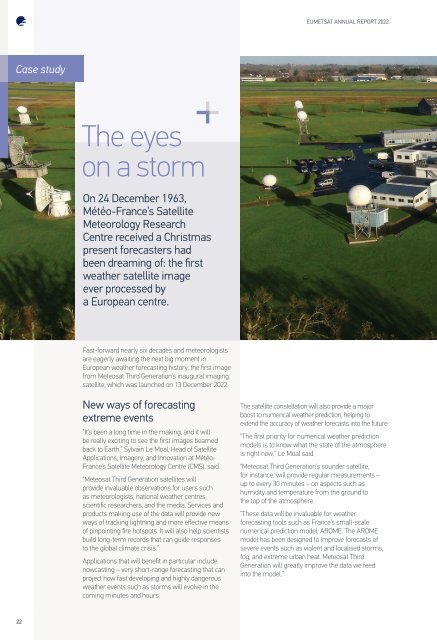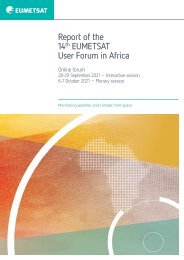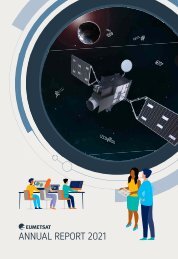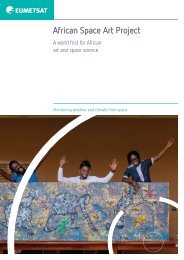EUMETSAT Annual Report 2022
You also want an ePaper? Increase the reach of your titles
YUMPU automatically turns print PDFs into web optimized ePapers that Google loves.
<strong>EUMETSAT</strong> ANNUAL REPORT <strong>2022</strong><br />
Case study<br />
The eyes<br />
on a storm<br />
On 24 December 1963,<br />
Météo-France’s Satellite<br />
Meteorology Research<br />
Centre received a Christmas<br />
present forecasters had<br />
been dreaming of: the first<br />
weather satellite image<br />
ever processed by<br />
a European centre.<br />
Fast-forward nearly six decades and meteorologists<br />
are eagerly awaiting the next big moment in<br />
European weather forecasting history, the first image<br />
from Meteosat Third Generation’s inaugural imaging<br />
satellite, which was launched on 13 December <strong>2022</strong>.<br />
New ways of forecasting<br />
extreme events<br />
“It’s been a long time in the making, and it will<br />
be really exciting to see the first images beamed<br />
back to Earth,” Sylvain Le Moal, Head of Satellite<br />
Applications, Imagery, and Innovation at Météo-<br />
France’s Satellite Meteorology Centre (CMS), said.<br />
“Meteosat Third Generation satellites will<br />
provide invaluable observations for users such<br />
as meteorologists, national weather centres,<br />
scientific researchers, and the media. Services and<br />
products making use of the data will provide new<br />
ways of tracking lightning and more effective means<br />
of pinpointing fire hotspots. It will also help scientists<br />
build long-term records that can guide responses<br />
to the global climate crisis.”<br />
Applications that will benefit in particular include<br />
nowcasting – very short-range forecasting that can<br />
project how fast developing and highly dangerous<br />
weather events such as storms will evolve in the<br />
coming minutes and hours.<br />
The satellite constellation will also provide a major<br />
boost to numerical weather prediction, helping to<br />
extend the accuracy of weather forecasts into the future.<br />
“The first priority for numerical weather prediction<br />
models is to know what the state of the atmosphere<br />
is right now,” Le Moal said.<br />
“Meteosat Third Generation’s sounder satellite,<br />
for instance, will provide regular measurements –<br />
up to every 30 minutes – on aspects such as<br />
humidity and temperature from the ground to<br />
the top of the atmosphere.<br />
“These data will be invaluable for weather<br />
forecasting tools such as France’s small-scale<br />
numerical prediction model, AROME. The AROME<br />
model has been designed to improve forecasts of<br />
severe events such as violent and localised storms,<br />
fog, and extreme urban heat. Meteosat Third<br />
Generation will greatly improve the data we feed<br />
into the model.”<br />
22









